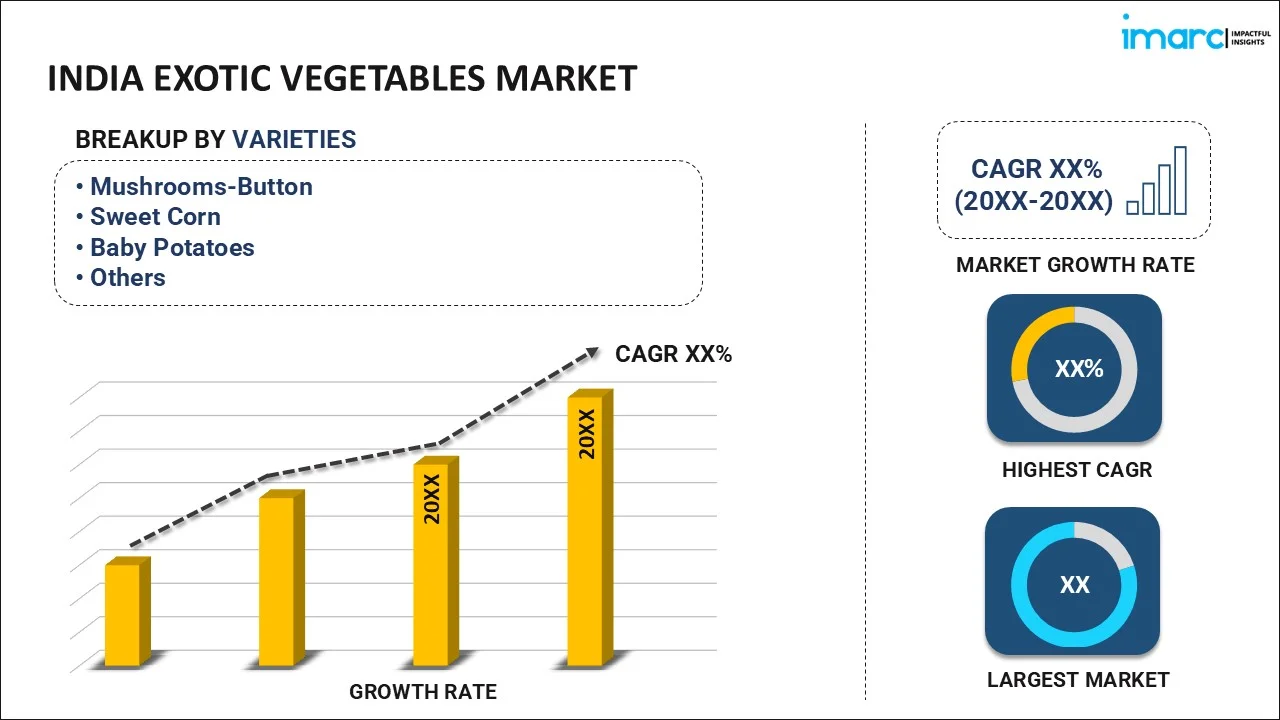
India Exotic Vegetables Market Report by Variety (Mushrooms-Button, Sweet Corn, Baby Potatoes, Cherry Tomatoes, Broccoli, Coloured Capsicum, Zucchini, Lettuce, Purple Cabbage, and Others), Sector (Organised Sector, Unorganised Sector), Distribution Channel (Supermarkets and Hypermarkets, Unorganised Retail Stores, Online Stores, and Others), and Region 2025-2033
Market Overview 2025-2033:
The India exotic vegetables market size reached USD 2.4 Billion in 2024. Looking forward, IMARC Group expects the market to reach USD 6.7 Billion by 2033, exhibiting a growth rate (CAGR) of 11.45% during 2025-2033.
|
Report Attribute
|
Key Statistics
|
|---|---|
|
Base Year
|
2024
|
|
Forecast Years
|
2025-2033
|
|
Historical Years
|
2019-2024
|
|
Market Size in 2024
|
USD 2.4 Billion |
|
Market Forecast in 2033
|
USD 6.7 Billion |
| Market Growth Rate 2025-2033 | 11.45% |
Exotic vegetables are vegetables cultivated in their non-native lands. The seeds for these vegetables are imported and grown in favorable climatic and weather conditions. They are commercially cultivated in greenhouses and net or poly houses and retailed at higher prices than the native vegetables. Some commonly available exotic vegetables include cherry tomatoes, broccoli, parsley, celery, lettuce, zucchini, baby corn, asparagus and bell peppers. These vegetables can be consumed raw and are also widely added to multicuisine dishes, salads, curries, soups and garnishes to enhance the aesthetic appeal and flavor of the product. They are a rich source of essential vitamins, minerals, fibers and antioxidants and can aid in managing weight and various medical ailments.
India Exotic Vegetables Market Trends:
Significant growth in the food and beverage industry across the country is one of the key factors creating a positive outlook for the market. Moreover, the shifting consumer preference toward international cuisines is providing a thrust to the market growth. Café, quick service and fine-dine restaurants are experimenting with exotic vegetables to provide their consumers with unique and authentic dishes and delicacies. In line with this, the increasing consumer participation in home-cooking activities for social gatherings and events is contributing to the market growth. Various exotic vegetables are also preserved, canned and pickled in brine for later consumption. Additionally, the proliferation of ecommerce and social media platforms and increasing brand endorsements with celebrities to reach a wider consumer base are favoring the growth of the market. Other factors, including rising health consciousness among the masses leading to the increasing demand for vegetables with higher nutritive content, along with the utilization of innovative hydroponics technologies for sustainable cultivation of exotic vegetables, are anticipated to drive the market toward growth.
Key Market Segmentation:
IMARC Group provides an analysis of the key trends in each segment of the India exotic vegetables market report, along with forecasts at the country and regional levels from 2025-2033. Our report has categorized the market based on variety, sector and distribution channel.
Breakup by Variety:

- Mushrooms-Button
- Sweet Corn
- Baby Potatoes
- Cherry Tomatoes
- Broccoli
- Coloured Capsicum
- Zucchini
- Lettuce
- Purple Cabbage
- Others
Breakup by Sector:
- Organised Sector
- Unorganised Sector
Breakup by Distribution Channel:
- Supermarkets and Hypermarkets
- Unorganised Retail Stores
- Online Stores
- Others
Breakup by Region:
- North India
- West and Central India
- South India
- East India
Competitive Landscape:
The competitive landscape of the industry has also been examined along with the profiles of the key players.
Report Coverage:
| Report Features | Details |
|---|---|
| Base Year of the Analysis | 2024 |
| Historical Period | 2019-2024 |
| Forecast Period | 2025-2033 |
| Units | Billion USD |
| Segment Coverage | Variety, Sector, Distribution Channel, Region |
| Region Covered | North India, West and Central India, South India, East India |
| Customization Scope | 10% Free Customization |
| Post-Sale Analyst Support | 10-12 Weeks |
| Delivery Format | PDF and Excel through Email (We can also provide the editable version of the report in PPT/Word format on special request) |
Key Questions Answered in This Report
We expect the India exotic vegetables market to exhibit a CAGR of 11.45% during 2025-2033.
The growing consumer preference towards international cuisines, along with the rising health consciousness regarding higher nutritive content vegetables, that aid in managing weight and numerous medical ailments, is primarily driving the India exotic vegetables market.
The sudden outbreak of the COVID-19 pandemic has led to the changing consumer inclination from conventional brick-and-mortar distribution channels towards online retail platforms for the purchase of exotic vegetables across the nation.
Based on the sector, the India exotic vegetables market can be bifurcated into organized sector and unorganized sector. Currently, the organized sector exhibits a clear dominance in the market.
On a regional level, the market has been classified into North India, West and Central India, South India, and East India, where North India currently dominates the India exotic vegetables market.
Need more help?
- Speak to our experienced analysts for insights on the current market scenarios.
- Include additional segments and countries to customize the report as per your requirement.
- Gain an unparalleled competitive advantage in your domain by understanding how to utilize the report and positively impacting your operations and revenue.
- For further assistance, please connect with our analysts.
 Inquire Before Buying
Inquire Before Buying
 Speak to an Analyst
Speak to an Analyst
 Request Brochure
Request Brochure
 Request Customization
Request Customization




.webp)




.webp)












